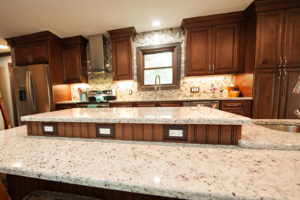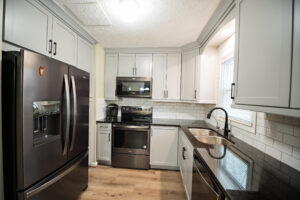
Granite is a common material used in kitchen countertops and it is much more expensive than some countertop materials as it is very durable. Granite countertops are also a bit more pricey due to their dense composition and weight. If you are curious how much granite weighs, keep reading for some common weight measurements for granite.
Types of granite countertops and thickness
The way that granite is formed in the earth causes the material to be composed of many different color patterns. Granite is mined and cut into large slabs by manufacturers. These slabs are cut into different sizes and thicknesses. A typical slab of granite will be cut into a piece measuring 4 to 5 feet in width and 7 to 9 feet in length. These pieces are also usually cut with a thickness of either ¾ of an inch or 1 ¼ inch.
Different Types of Granite Finishes
Granite countertops come in various finishes, which can affect their appearance and maintenance needs. Common finishes include polished, honed, and leathered. Polished granite has a shiny surface that enhances the stone’s natural colors and patterns. It’s easy to clean but may show fingerprints and smudges. Honed granite has a matte finish that provides a softer look and feels smooth to the touch. It is less slippery and hides scratches well, but it can be more susceptible to staining. Leathered granite has a textured surface that gives a more natural and rustic look. This finish is less prone to showing fingerprints and provides a unique appearance.
How Granite Countertops Affect Kitchen Design

Granite countertops can significantly impact the overall design of your kitchen. Due to their natural beauty and unique patterns, granite can serve as a focal point in your kitchen. Choosing a color and pattern that complements your cabinets and flooring can create a cohesive and elegant look. Additionally, granite’s durability makes it a practical choice for high-traffic areas in the kitchen. It can withstand heat, spills, and everyday wear and tear, making it both a stylish and functional option.
Granite Countertops and Weight Distribution
Proper weight distribution is crucial when installing granite countertops. Because granite is heavy, it’s essential to ensure that your kitchen cabinets are strong enough to support the weight. Cabinets should be checked for stability and reinforced if necessary. If you’re installing a large granite countertop or a kitchen island, extra support might be needed. This can include additional brackets or support beams to prevent any potential issues with sagging or damage to the cabinets.
Maintenance Tips for Granite Countertops
Granite countertops are durable, but they still require regular maintenance to keep them looking their best. To maintain the appearance of your granite, it is important to clean spills promptly to prevent staining. Use a mild dish soap and water for daily cleaning, and avoid harsh chemicals that can damage the sealant. It’s also a good idea to reseal your granite countertops periodically, as this will help protect the surface from stains and damage. Check the manufacturer’s recommendations for sealing frequency to ensure your granite stays in top condition.
The Cost of Granite Countertops
Granite countertops can be more expensive compared to other materials due to their durability and unique appearance. The cost of granite depends on several factors, including the type of granite, thickness, and the complexity of the installation. Generally, granite prices range from $40 to $100 per square foot, with higher-end granite varieties costing more. When budgeting for granite countertops, it’s important to consider both the material costs and any additional expenses for installation and maintenance.
Why Choose Granite for Your Kitchen

Granite is a popular choice for kitchen countertops because of its natural beauty, durability, and variety of color options. It adds value to your home and provides a high-end look that many homeowners desire. The unique patterns and colors of granite ensure that each countertop is one-of-a-kind, offering a personalized touch to your kitchen design. Additionally, granite’s resistance to heat and scratches makes it a practical choice for busy kitchens.
Common weight measurements of granite
Granite is commonly measured in weight by square feet. Considering that granite countertops are cut into different thicknesses they both have different masses and weights per square foot. Granite that is cut into a thickness of ¾” is about 13lbs per square foot, where granite cut at 1 ¼” thickness is about 18lbs per square foot.
How big is the average granite countertop slab
An average size granite slab that might go into your kitchen can weigh anywhere between 700 and 1200 lbs. You can have your granite countertops sized however large your space is needed, but the larger it is the heavier it will be. If the granite slab is too heavy for your cabinets to support, additional structural support may be implemented into your cabinetry. Kitchen island countertops for example can be anywhere from 5 to 10 feet in length.
How are granite countertops moved?
Since granite countertops are so heavy, it is hard to imagine how they are transported into your kitchen. When moving granite, it is important that the stone is carried in a vertical position so that it will not crack or break under its own weight. Smaller pieces of granite can be carried by 2 to 4 people, whereas larger slabs can be rolled on small carts. If slabs are too large for entry into a home, they are sometimes sectioned into pieces and united at the time of installation.
Kitchen Express Granite Installation
At kitchen express, we can install your granite countertops for you. We will make sure that your granite countertops are the color and size that you specify. We have been remodeling kitchen spaces for a very long time, and we will make sure that your new countertops look just the way you imagined them.
